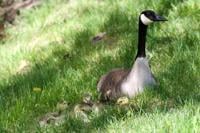SALT LAKE CITY – Springtime is when birds are hatching and some hatchlings may leave the nest early. The Utah Division of Wildlife Resources has a few tips for people who find baby birds while going for a walk.
This time of year bird eggs will hatch and sometimes get separated form the mother.
Baby birds on the ground during this time of year are common. Many birds are hatching and often leave their nests before they are able to fly. Some could have blown out of nests during spring windstorms.
“Baby birds usually chirp and call from the nest, waiting for their parents to bring food to them,” said Utah Division of Wildlife Resources Migratory Game Bird Coordinator Jason Jones. “Sometimes they get excited or agitated, which results in them falling from their perch.”
Some of the most common babies people find are robins (which nest in trees) or swallows (which build their mud nests in eaves and on the sides of houses).
There are a few things DWR recommends when one finds a baby bird.
Put it back in the nest if it doesn’t have feathers
If the bird is very small and still featherless, place it back in its nest. If someone can’t find the nest, put the bird on a branch safely out of reach of dogs and cats.
“The baby will squawk, and its parents will find it,” Jones said.
Most birds do not have a good sense of smell so when a baby bird is picked up, its parents won’t even know you’ve handled it.
Never take a baby bird home. Most birds are protected by state and federal laws, and it is against the law in Utah to possess wild animals without a special permit.
Leave it alone if it has feathers
If the baby bird is hopping around, you’ve found a bird that almost isn’t a “baby” anymore. These young birds are called fledglings. They have most of their flight feathers and are very close to taking their first flight.
If the bird isn’t in danger, leave it where you found it. This awkward “hopping” stage typically lasts two to five days. It’s part of the natural process a baby bird goes through before taking its first flight. The parents are watching the baby bird and are still feeding it.
If you think the fledgling is in immediate danger, then move it carefully to a safer spot nearby. However, if you can’t catch the bird, just leave it alone.
Don’t feed the bird
If you find a baby bird, don’t attempt to give it food. Birds have a very specific diet and feeding them something that’s not part of their diet can kill them.
“While robins and some bird species can safely eat worms, others can’t,” Jones said. “So don’t try to feed baby birds or other wildlife that you encounter. You may think you are ‘helping’ them, but it usually does more harm than good.”
Just place the bird back on its branch or in its nest, and let its parents feed it.
Don’t bother or move bird nests that have eggs or baby birds in them
While bird species that nest in the eaves of buildings may seem like a nuisance, it’s unlawful to disturb nests that have eggs or baby birds, and you can be cited for doing so.
You can take measures to prevent birds from building nests on your home or property, but you have to do it before nesting season begins. Once a bird establishes and inhabits a nest — and there are eggs or baby birds in the nest — you need to wait until after the baby birds have left the nest in order to remove it to prevent future nesting.
What to do with baby ducks
If a duckling is found on the ground that looks like it’s been separated from its parents, don’t move it or try to put it in water. Baby ducks should be left alone, unless they are trapped in a storm drain or somewhere else dangerous, like in a swimming pool.
If a duckling is found in a storm drain, contact the nearest DWR office to report it or contact your city officials.
Avian flu
Songbirds are not typically affected by highly pathogenic avian flu viruses, so people shouldn’t have to remove their bird feeders unless they also have backyard chickens or domestic ducks, which are susceptible to the virus. However, DWR recommends regularly clean bird feeders and baths.
If a group of five or more dead birds in one area, report it to the nearest DWR office and make sure not to touch the birds or pick them up.
For more information about how to safely handle a baby bird encounter, visit the Wild Aware Utah website.


